Elegant. Mysterious. Perfection.
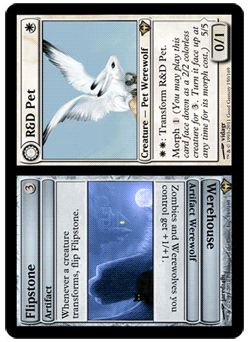
Elegant. Mysterious. Perfection.

JoINrbs pilots a customized UR Post deck through a Pauper DE. Notable changes include [card]Deep Analysis[/card] over [card]Mystical Teachings[/card].
JoINrbs builds the deck while explaining how it works.
Stick around at the end for some analysis of [card]Surging Flame[/card], which turns out to be bad card. Certainly much worse than [card]Needle Drop[/card], which is the best card in the world.
There are also some chess tactics vs. the slightly disfavored black pieces.
[card]Needle Drop[/card], still the best card in the world.
Not a great game pre-board. Post-board, the entire deck changes, and it becomes a battle of [card]stone rain[/card]s.
Be sure to stop by the forums thread to weigh in with your feedback!
Poker prodigy JoINrbs takes us through a match of Ascension versus various decks on MTGO. Since this is exclusive premium content, he recorded his face so you can watch him while he plays!
Ascension vs. Infect
Just playing and talking and picking my nose.
Ascension vs. Goryo
There is an entire game in this match where I know what my opponent is playing.
Amid all the buzz surrounding Wizards’ new “Planeswalker Points” system, there’s one pocket of dissent that you may not have heard from yet, but soon will. I’m speaking of course, of the girlfriends and wives of Magic players.
“The changes to organized play will have a devastating effect on all of us,” said one disgruntled girlfriend, who was seen picketing outside the Wizards building on Tuesday afternoon. “There are at least 17 of us worldwide, and we’re all mad as hell.”
The ladies’ concern stems from the fact the new system rewards volume of play instead of quality of play.
“Previously, Steven would get a good finish and then sit on his rating until Worlds invites,” said another picketer between sobs. “We used that time to focus on activities we both enjoy, like picking out new towels for the guest bathroom or going jewelry shopping. Now, he’ll have to play constantly just to keep up! This is just awful!”
In the face of mounting opposition, a Wizards spokesman released the following statement: “At Wizards of the Coast, we believe in making decisions that benefit the majority of our customers, and we just don’t see this as an issue for most of our player base. Seriously, have you seen those guys? Christ.”
But some magical girlfriends have already begun to cook up a plan to combat the hated points system.
“The way we see it, you have to fight fire with fire,” a representative told us. “Enter girlfriend points.”
She was kind enough to offer us an exclusive look at some preliminary point values.
Surprise chocolate
Surprise flowers
Surprise pony
Cuddling during movie
Cuddling during romantic comedy
Cuddling during “Twilight”
Telling me I look pretty and convincing me you’re not just saying that for the point
Assenting to my psychological assessments of our friends
Buying me that thing I’ve been hinting that I want
Out playing Magic
Out drinking with the guys
Out at the strip club
Out playing drinking Magic with the guys at the strip club
In public
In front of my girlfriends
In front of my ex
While I’m on my period
“We’re still working out the kinks in the system. For example, it might still be too easy for our boyfriends and husbands to think and talk about Magic while eating dinner,” she added.
You can find out more about this exciting new system by calling your wife or girlfriend today!
|
by Fake Mark Rosewater |
 |
Here at Wizards of the Coast, our work – like the work of Sir Isaac Newton before us – is all about experimentation. Whenever we introduce an exciting new idea, we are testing the waters to see what works and what doesn’t, and what we can rehash further down the line. The ‘free spells’ mechanic in Urza block was a huge success, so we revisited it in New Phyrexia. Increasing planeswalker complexity and utility with [card]Jace, the Mind Sculptor[/card] didn’t cause any problems, so we decided to push forward with the five-ability Garruk Relentless, who requires a degree to operate correctly.
With Innistrad we attempted the largest experiment of all, the Magic R&D equivalent of the Large Hadron Collider: double-faced cards. Although [card=Richard Garfield, Ph.D.]St. Richard Garfield[/card] originally intended to use card-backs as a means to differentiate between expansions, for the past eighteen years the reverse of a Magic card has been considered sacred ground. Imagine if we could unlock the full powers of both sides of a Magic card – that’s 100% more design space then we’re currently using. In this economic climate, that’s exactly the kind of efficiency-increasing solution we need to be coming up with.
Double-faced cards, of course, have been hugely successful. Meeting with a glowing community reception since they were first spoiled, DFCs have consistently smashed any misgivings that might have been initially held with regards to issues like shuffling and drafting. The fact of the matter is, the idea of a CCG that uses a standardized card-back to conceal information is antiquated. I have previously stated that Innistrad is the beginning of a seven-year plan; by the end of these seven years I hope for every card in Magic to have a completely unique card-back.
We understand that this will be a lot to take in, so rather than leap right in with flip-morph-transform cards that have a card from an entirely different CCG on the reverse, we will be introducing staggered changes to the card-back over the next few sets. Dark Ascension brings us the first and most obvious addition: Color-coding. Starting next February, all card-backs will be subtly recolored to indicate rarity.
I could talk for pages and pages about how great an idea this is, but it might be more interesting for you if I answered a few of your questions instead! Here, then, is the official preliminary card-back FAQ!
What about opaque sleeves?
To properly accommodate the new card-backs, we will regrettably be forced to disallow the use of opaque sleeves from all Magic tournaments. If you really don’t want to go Au-natural, we are pleased to announce that our friends at UltraPro will be selling ‘booster packs’ containing eleven common-backed sleeves, three uncommon-backed sleeves, and one rare-backed sleeve. A small proportion of these packs will even contain a mythic rare sleeve!
While I’m sure that UltraPro’s new product will be of the highest quality, I can’t afford to collect all these sleeves. Must I risk damage to my precious collection?
We’ve got you covered – we will be giving players the option to swap their library with sixty checklist cards.
Doesn’t this mean that all card rarities will be public information?
It absolutely does – we feel that knowing when your opponent is about to draw their mythic bombs will add a strategic dimension to the game, not take anything away from it.
Aren’t you worried about the possibility of cheating used marked card-backs?
Nope!
Tune in next time for the reveal of the next stage in the evolution of the cardback!
My top 8 predictions (decklists here):
Sjoblom (Ascension) vs Nakajima (Affinity):
Sjoblom is going to be hating those remands and muddles preboard, and his combo kills all suffer from his opponent having 20 life. Winning the roll will help, but even then he’s going to be an underdog g1. Maybe you live the dream and have someone [card]Fling[/card] into [card]Remand[/card] at FNM, but in the top 8 of a PT with public decklists he really has no tricks and his deck looks to be about half a turn slower than his opponent’s.
Postboard the matchup doesn’t improve. A single [card]Shattering Spree[/card] is the only great value he’s getting out of the board, while his opponent gets four copies of [card]Mindbreak Trap[/card]. Trap can be quite underwhelming, but backed up by a good clock it’ll push the matchup even more in Nakajima’s favor, and I’m going to give him the benefit of the doubt and assume he isn’t going to be keeping any 2x trap 2-power of creatures hands.
All that said, these decks don’t interact very much at all, and other than fairly basic sideboarding and mulliganing I don’t think there is much room for play for either player. Sjoblom might try to force play by leaving [card]Remand[/card] up or something but that just seems terrible. A lot of it is just going to come down to who gets the better draws.
Nakajima over Sjoblom with 65% equity.
Prost (Ascension) vs Estratti (Twin):
I like Prost’s build of Ascension a decent amount more than Sjoblom’s, but he still suffers from Remands, and also has a jaw-dropping FIVE non-blue lands (although he does have three lands more than Sjoblom overall). Lands are great for Ascension vs Twin, but those [card]Grove of the Burnwillows[/card] are looking quite silly in a matchup about casting blue spells around creatures which tap your lands. At least there are no copies of [card]Gigadrowse[/card] in Estratti’s 75.
Preboard Prost needs to keep [card]Deceiver Exarch[/card] off the board with [card]Remand[/card] and [card]Mana Leak[/card] long enough to set up a win. He has four copies of [card]Noxious Revival[/card] thank god, but his counters put him in a very awkward spot as soon as Twin can represent the kill as he lacks blue mana to continue casting cantrips while holding up counterspells. While his four copies of [card]Lightning Bolt[/card] are not completely dead, they are a unappealing backup, as any time he is pointing them at Kiki-Jiki he risks losing to [card]Pact of Negation[/card], which is otherwise a dead card in the matchup.
My brain sort of overdrives here; very complicated matchup. I think Twin has a tiiny edge g1 thanks to a lower chance of misfiring (every Twin list should have those combo extra pieces!) and a slightly better maindeck for the matchup, and depending on board plans could definitely do well post board as well. I like +1 Clique, +2 Engineered Explosives, +1 Deprive, -3 Firespout, -1 Lightning Bolt.
Postboard Prost has absolutely nothing and Twin improves a fair amount, giving Twin a decent edge in a 5-game set. Ascension needs cards like [card]Dream’s Grip[/card] and [card]Boomerang[/card] here to find a way to slow Twin down a turn and get the combo off. Without them it’s just a speed coinflip with better disruption and flexibility for Twin.
Estratti over Prost with 60% equity.
Hampton (Post) vs Black (Shoal):
lol GG preboard. I love Black’s list btw, it is miles and miles better than the other lists we’ve seen. The redundancy is very good. My only concern is that he’s playing just eight infect creatures and once your opponents know that their boarding and postboard game become both quite obvious and very effective. Post is just so slow that he can find plenty of counter backup and win the game though. The board with 3 [card]Punishing Fire[/card] (put one of these maindeck? seems obvious) and 2 [card]Dismember[/card] will help a little, but even postboard Post’s plan is not extremely compelling,
Black over Hampton with 75% equity.
Utter-Leyton (hope your deck sucks) vs Portaro (Twin):
The PT’s combo decks are woefully built and inconsistent, and Kibler’s team has done a good job of capitalizing on this by playing a fairly bad deck which can surprise people with 80 IQ and five [card]Seething Song[/card]s. Unfortunately they missed the [card]Arena[/card] + [card]Knight of the Reliquary[/card] tech for this matchup, and without it they have a total of five relevant cards preboard (okay I guess 9 if you count [card]Green Sun’s Zenith[/card] for [card]Qasali Pridemage[/card]). ([card]Punishing Fire[/card] yu).
Meanwhile the Twin deck Utter-Leyton is up against is not a poorly made deck at all. Streamlined and consistent, the deck looks highly polished and effective. With little help from the board and his rogue list completely public I expect Utter-Leyton to get Utter-Stomped here.
The most interesting part of this matchup in my opinion is whether Portaro boards in [card]Blood Moon[/card]. I think it’s good enough on the play, but doesn’t make the cut on the draw. He has about 70 playable cards to choose from postboard so there’s a lot of room for play for him there, and the match may ultimately pivot on his boarding strategy (or more likely whether the match is 3-0 or 3-1 may do so).
Portaro over Utter-Leyton with 70% equity.
SEMIFINALS
Nakajima (Affinity) vs Estratti (Twin):
I don’t know much about this matchup, but feel like it has to be tilted heavily towards Affinity’s side of the aisle preboard on the back of 4x [card]Galvanic Blast[/card] and a good clock. Four damage turns out to be just the perfect amount. With 1 [card]Shrapnel Blast[/card] and even 2 [card]Fling[/card] Affinity has seven good (well, five good, two passable) disruption spells coupled with an explosive clock.
Public decklists definitely favor Affinity preboard too, as he gets to know exactly what he’s worried about (not much). No bounce, 1 [card]Lightning Bolt[/card], 1 [card]Disrupting Shoal[/card] (this could potentially cause a blowout vs [card]Fling[/card]), and 3 [card]Firespout[/card].
Postboard public decklists definitely favor the combo player, who gets to see exactly what hate is coming in against him. In this case it’s just 3 [card]Torpor Orb[/card], and I have to imagine Estratti will be happy to see that, packing 2 [card]Ancient Grudge[/card] and 2 [card]Engineered Explosives[/card] which were already coming in and deal with it nicely. Even so, the matchup doesn’t change greatly after boarding, and it still looks to favor the artifact men to me.
Nakajima over Estratti with 60% equity.
Black (Shoal) vs Portaro (Twin)
This is going to be a crazy matchup (okay, if it happens. My predictions aren’t actually reality… yet. I hope it happens). Look at all those cheap counterspells. Both decks pack [card]Pact of Negation[/card] to power through their combo in situations where they sometimes can’t pay the mana if they see their next upkeep, and a self-inflicted Pact death with all the free/cheap counters lying around is a real possibility.
It’s hard to understate how amazingly good [card]Gitaxian Probe[/card] is in this matchup. Perfect information? Yes please! Twin has so many different modes – “kill you now!” all the way to “counter your threats and then do nothing until turn 15” – that learning exactly where your opponent stands is greatly valuable. Unfortunately Black is only playing two.
He has 1 [card]Watery Grave[/card] to fetch, meaning [card]Slaughter Pact[/card] is a real option… only he only has one of them and it’s in his board.
I also have no idea how boarding works here for Black. It looks like Black could reasonably board in every card in his sideboard, but there isn’t anything obvious to take out. Meanwhile Portaro has tough decisions of his own. [card]Blood Moon[/card] shuts off [card]Inkmoth Nexus[/card], but it’s so slow and requires tapping out. Is [card]Firespout[/card] good enough? The best plan in my eyes is to give up on the sorcery-speed spells entirely, and try to fight at instant speed. [card]Dreadship Reef[/card] would be amazing here but isn’t in the list. With 1 [card]Dismember[/card], 4 [card]Punishing Fire[/card], 4 [card]Remand[/card], 2 [card]Spell Pierce[/card], 2 [card]Pact of Negation[/card], and 2 [card]Dispel[/card] I think you’re even at a point where you can bring in 2 [card]Mindbreak Trap[/card] and expect to cast it for 0 on the critical turn.
To make room for this I would be boarding out win conditions. Goodbye Kiki-Jiki and Splinter Twin! It’s just unrealistic to expect to tap out and not lose immediately here. Instead I would rely on end of turn [card]Punishing Fire[/card] recursion and 2 [card]Vendilion Clique[/card] to win the game.
This seems like a very counter-intuitive strategy for a Twin player, and I’m not optimistic that it gets played, but Portaro made it to the top 8, and hopefully he’ll be creative enough to find it and give it a try. If he does I think Black has a LOT of trouble getting through short of god drawing. Looks to be a thrilling and complicated matchup!
Portaro over Black with 60% equity (assuming good boarding).
FINALS
Nakajima (Affinity) vs Portaro (Twin):
Not too much has changed between this round and last for Nakajima. Affinity looks to be a favorite over Twin in my eyes, but not overwhelmingly so, and Affinity always has the chance of choking on itself. However, Portaro’s list I believe is better equipped for this matchup, with [card]Firespout[/card] (four postboard) and [card]Punishing Fire[/card] recursion (also up to four). Portaro has plenty of mediocre counterspells to board out, but only TWO answers to [card]Torpor Orb[/card] to bring in.
Given how much trouble he has answering [card]Torpor Orb[/card], I like the idea of boarding out a few combo pieces again here for Twin. Could we see [card]Punishing Fire[/card] recursion taking down both the semis and the finals of this “fast” modern format’s PT? I for one would not be too surprised.
Portaro over Nakajima with 55% equity.
So there you go. I think Twin will win this PT by boarding out the Twin combo. What do you think?
Earlier this year, the controversial decision was announced to ban [card]Jace, the Mind Sculptor[/card] from standard tournaments. In his article explaining the banning, Director of Magic R&D Aaron Forsythe expressed his regret that Jace, who leaves the format in October, “nearly made it this time”. “Of course we were wary about reprinting a card with a history like Jace’s, but the higher power of modern standard environments allowed us to reintroduce cards like [card]Lightning Bolt[/card] and [card]Stone Giant[/card] last year. We thought we were ready for Jace. We were wrong.”
Surveys taken at FNMs across the world revealed that although 68.5% of players thought the banning was justified, less than ten percent were even aware of the card’s lineage. Several local scrubs insisted that Planeswalkers were only introduced in the Lorwyn expansion until we showed them an original beta Jace.

Jace, the Mind Sculptor was one of the cornerstones of early magic tournaments, providing a much-needed win condition for drawn-out control mirror matches. Under the original rules Jace’s ‘counts as a player’ clause meant that the card could not be countered and had to be provided with its own seat; when reprinted last year, these rules were done away with for logistical reasons.
After a pro player tragically died of dehydration during a week-long match involving [card]Stasis[/card], [card]Time Elemental[/card], and chained [card]Timetwister[/card]s, the DCI realised something had to be done, and banned Jace outright from all further tournaments. Jace remained banned from even vintage events due to health and safety risks until its printing last year in the Worldwake expansion.
While Jace proved too powerful for the current standard environment, two other Zendikar block reprints of once-banned cards failed to achieve the level of noteriety they once commanded. [card]Obsidian Fireheart[/card] originally required players to physically set their lands on fire, and its infamous ‘the land continues to burn’ wording was interpreted to mean that if a card went out prematurely, its controller could be issued a loss for failing to maintain the game state. [card]Emrakul, the Aeons Torn[/card], remembered fondly by collectors for its confusing printed mana cost and meaningless ‘legend-gold’ frame, was briefly outlawed from tournaments after Wizards of the Coast’s lawyers expressed concerns over the phrase ‘spells with colour’. Ironically, Emrakul was in another sense one of the most racially progressive creatures in Magic, as the first card to be printed with two subtypes.
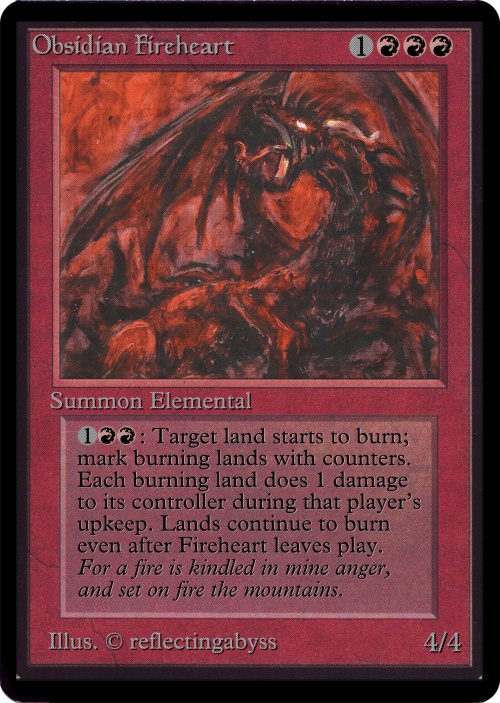

Are you determined to buy the next Magic: the Gathering collectable deck, but don’t yet know what it is? Have you been to the wizards.com website looking for the latest Magic products, only to turn away lost and bewildered?
Fear not, woeful spell-slingers! Good Gamery has a special announcement: we’ve been asked by Wizards of the Coast to join them for an exclusive partnership! With the unprecedented popularity of Commander, Archenemy, Duel Decks, From the Vault, Premium Deck Series, Event Decks, and the Deckbuilder’s Toolkit, the good folks at Wizards are keeping busy designing ways to sell you cards they’ve already printed. But their web marketing team is not able or willing to keep up with the deluge of new products. That’s where GoodGamery comes in.
We’ve agreed to devote some of our front page to alerting you to the newest Magic products. By virtue of their sheer quantity, we’ll have the privilege of spoiling some of these first! You’ll doubtless see many, many of these in the coming weeks, so start making room on your shelves and closets and apologizing to your loved ones. For now, follow this link for a taste of what’s to come:
We know what you’re thinking: how big is that vault? Bigger than you can possibly imagine. Remember to check our front page regularly for the newest one-of-a-kind Magic products!
Richmond, VA (AP) Ben Bleiweiss, a 33-year old kid at heart, cast [card]Earthquake[/card] for 6, setting off seismic activity that rocked the entire eastern seaboard of North America between 2:00 and 2:15 pm on Tuesday, USGS authorities said.
“We were just playing a group EDH game in the lounge of our sales department at the Richmond office when suddenly the room started rocking,” said Bleiweiss, visibly shaken.
“I don’t think that was the cause. I’m guessing it was Misterorange’s [Evan Erwin] [card]Hive Mind[/card],” said The Ferrett, who was still standing out in the parking lot with dozens of other editorial staff. “Granted, playing ‘quake on top of that wasn’t really well thought out,” he added.
“Could have been the [card]Terastodon[/card] I had played the turn earlier,” mused Mike Flores. Bleiweiss shook his head.
The [card]tremor[/card] caused a minor emergency alert at the [card=Pentagram_of_the_Ages]Pentagon[/card], and briefly stalled trading on Wall Street. It was also reported as far north as Toronto and New Brunswick, where it unleashed a tsunami of staid Canadian apathy.
President Obama, on holiday at Cape Cod, noticed the tremor and said “Eight people at the head of the largest online card trading store in North America, and nobody is packing a [card]Stifle[/card]. Dayum, son.”

Briefly, slimes are complex organisms somewhere between algae and sponges. They also have qualities shared with bacteria and with fungi, namely phagocytosis and asexual reproduction. Unlike these kingdoms however, slimes are eukaryotes with behaviour-driven motility and lack a cell wall.

A slime has a top or lid, face, sides or sidewalls, rear wall, and a base. Living slimes are always oriented thus, and instantly re-orient themselves base down whenever they are tilted or fall at an angle. This is due to the statocyst or positional sensor organ in the slime’s lid. It functions like a primitive inner ear to orient the slime in space.
Other important anatomical landmarks of the slime include:
The capsule of the slime is tough and elastic, like a tendon or a thick sheet of rubber. Inside the capsule, the slime consists of three specialized areas, arranged roughly from front to rear.
The commercial slimeball is actually made up of the elasmosomes of freshly killed slimes.
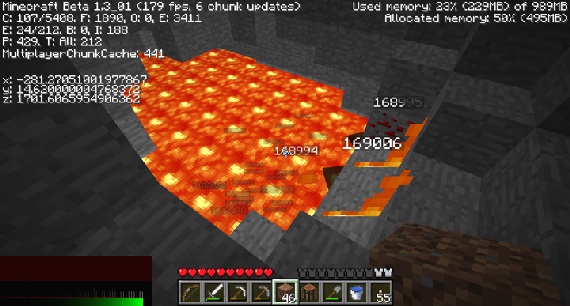
This herd of slimes occupied the lava pool shown here for several minecraft days.
Slimes are found deep underground, in areas where constant high temperature and humidity prevail. Since slimes are facultatively photosynthetic, they thrive in and around caverns lit up by magma flows, volcanic vents, and even the high energy lamps used in deep shaft mining. Due to their thick chiton, they are notoriously resistant to fire and burns.
Since slimes require oxygen to live, they rely on their symbiotic zoochlorellae to provide a small amount. Transplanting a slime into a totally dark oxygen-poor volcanic flue or sulfur vent can suffocate it. However, if a light source is provided, the slime may survive indefinitely (although it will not grow or reproduce).
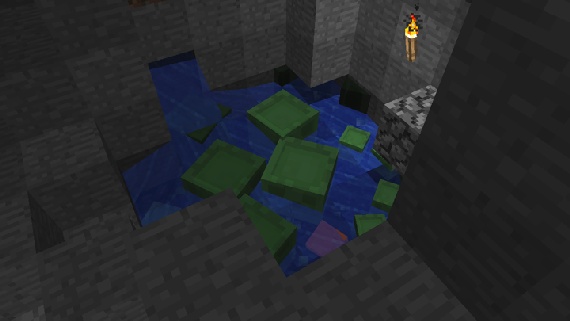
The small slime in the center foreground is drowning.
Slimes are limited to areas where water and ambient moisture are high. Although they can desiccate if stranded or trapped in dry air, they can retain a lot of water and this allows them to migrate long distances to new caverns.
Contrary to popular belief, slimes can’t swim and they do drown when submerged in water. Commercial elastics harvesting relies on large deep pools or moving conveyors to drown young slimes.

These slimes are migrating from a dry underground tunnel system to a freshly opened mineshaft, which is still damp.
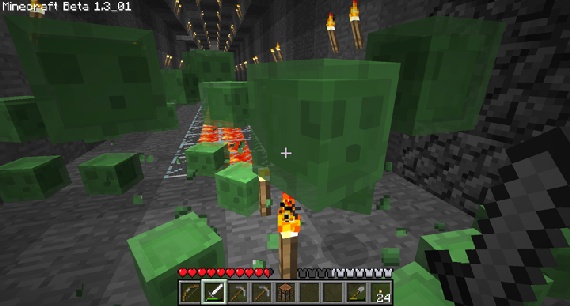
Slimes of all sizes and life stages in a stampede, a rare and dangerous phenomenon associated with strip mining or flood mining.
Slimes reproduce either sexually (details unknown) or asexually (fission) to produce daughter slimes. The daughter slime or calf is less than 1 m cubed and has little or no enzymatic activity. It contains relatively more nutrients in the form of inclusions. These sustain the small slime until its own enzymes mature.
As the slime grows, it becomes capable of engulfing items for food. These digestive properties of the chiton may cause damage on contact with the slime. When it is roughly 8x the weight of a new calf slime, it can reproduce by fission. This often happens when the slime is damaged – the slime divides along a defect in the capsule, healing the defect and producing up to four daughter slimes.
A mature slime is quite large, slow-moving, and heavy. It has a relatively low moisture content compared to the youngest slimes. To compensate, it produces more concentrated digestive enzymes and acids which are toxic to nearby lifeforms. As a slime ages, its elasmosome loses elasticity and tends to calcify. This can result in large, old slimes getting trapped in corridors or narrow spots and suffocating.
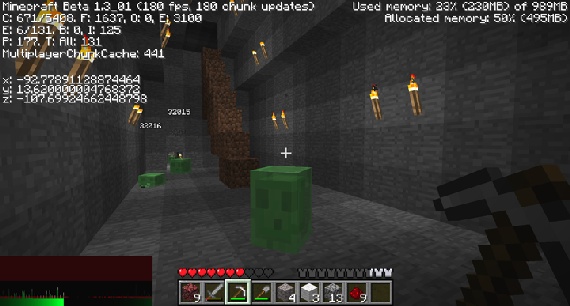
Slimes have a remarkable elasticity. This image shows the range of slime compressibility in normal locomotion. Slimes may fit through doors and in stairwells that appear to be much too small.
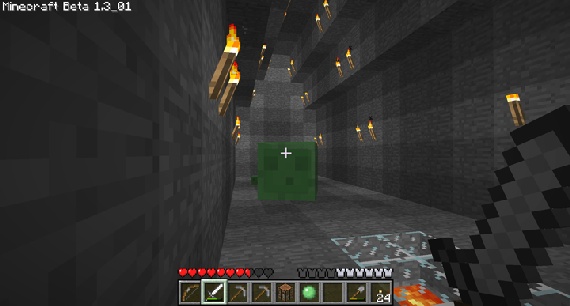
A matriarch slime protecting a daughter.
Slimes are found in herds throughout the world, always in geothermally favourable chunks. Although slimes do not exhibit nesting behavior or any other advanced social system, they do have a primitive herd behavior wherein the larger slimes may protect the smaller ones. Small slimes in a herd may collectively push invaders away from resources or off precipices. Slime intelligence is otherwise rather low.

Are these slimes identical, or fraternal, twins?
Scientists are not sure how to classify slimes. So far no one element of slime anatomy or microanatomy definitely places them in either class. The slime has features of both:
Perhaps the strongest evidence for slimes being multicellular is the macula, which doesn’t appear to have a direct physical communication to any other part of the slime, but activates locomotion and storage of trace metals in other parts of the slime.
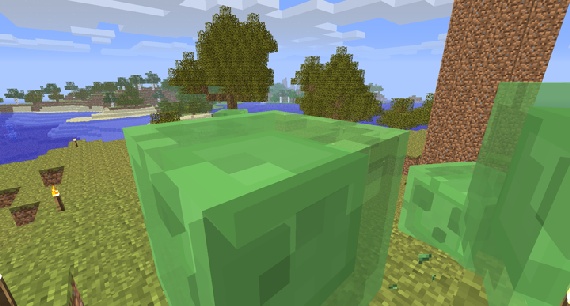
Slimes in a slime game park enjoying a brief moment in full sun.
Slimes have been transformed by popular culture over the past 5 expansions. The slime is a strong symbolic figure in the human psyche as a rare, elusive, dangerous, alien, even droll and endearing creature. Modern technology relies heavily on slimeballs as a commercial product, from slimes grown in artificial labs in great numbers under ideal conditions. One disturbing development is the breeding of slimes for populating slime parks and safaris. Slimes are bred and brought to the surface and exposed to sunlight. This causes them to take on an intense green color and become agitated. They are then released into well-tended parkland and hunted from the air or the roadside. Some parks let hunters use packs of hunting dogs. This last is exceedingly cruel for both the slimes and the dogs.
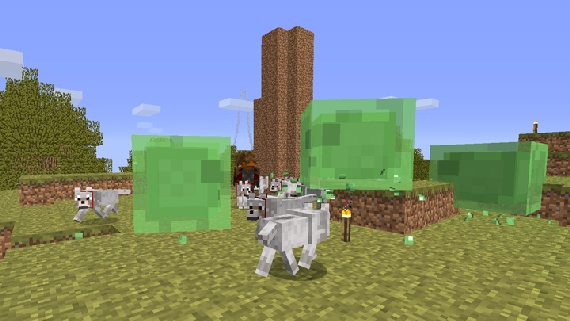
Hunting slimes with dogs is illegal in several countries.
Slime petting zoos are common children’s roadside attractions in mining towns. Because the smallest slimes are innocuous, they can be held and petted. Sadly, they are force spawned by slimepunching, wherein adult slimes are placed in a machine and pummeled with pistons or even a handler’s gloved hands. The slimes accumulate damage and eventually split off daughter slimes. Once tourist season is over, the baby slimes are frequently drowned or dropped off a ledge. The resulting slimeballs are then sold to elastics firms.
The Slime Protection Agency was founded in 2010 to protect slimes from exploitation and promote humane industrial and commercial slimeball harvesting.
Since then Dupont has developed the first artificial elastic material for making sticky pistons. Slimes remain a curiosity and are still subject to abuses as pets and trophy game mobs.